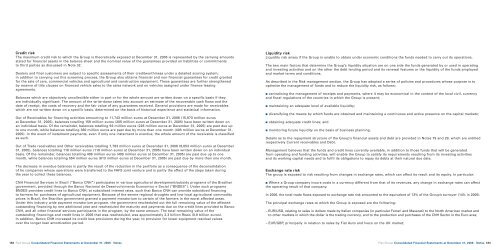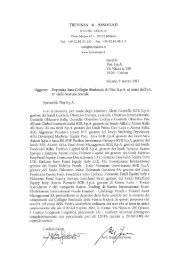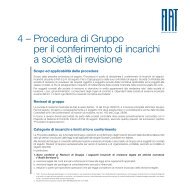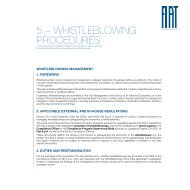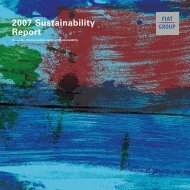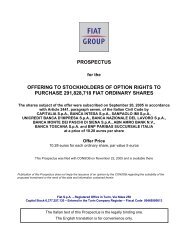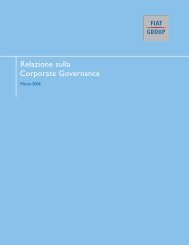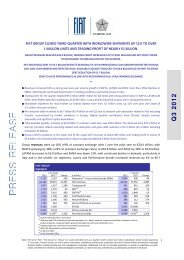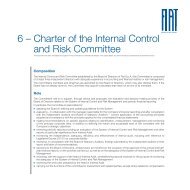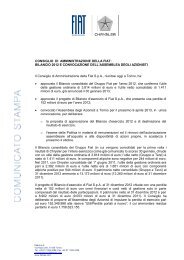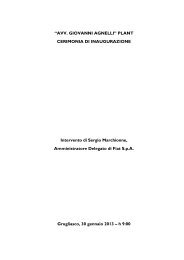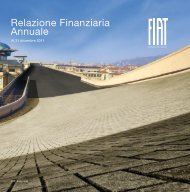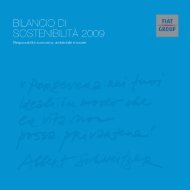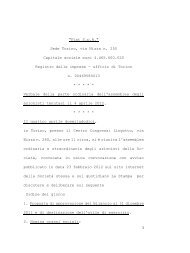2006 Annual Report - Fiat SpA
2006 Annual Report - Fiat SpA
2006 Annual Report - Fiat SpA
Create successful ePaper yourself
Turn your PDF publications into a flip-book with our unique Google optimized e-Paper software.
Credit risk<br />
The maximum credit risk to which the Group is theoretically exposed at December 31, <strong>2006</strong> is represented by the carrying amounts<br />
stated for financial assets in the balance sheet and the nominal value of the guarantees provided on liabilities or commitments<br />
to third parties as discussed in Note 32.<br />
Dealers and final customers are subject to specific assessments of their creditworthiness under a detailed scoring system;<br />
in addition to carrying out this screening process, the Group also obtains financial and non-financial guarantees for credit granted<br />
for the sale of cars, commercial vehicles and agricultural and construction equipment. These guarantees are further strengthened<br />
by reserve of title clauses on financed vehicle sales to the sales network and on vehicles assigned under finance leasing<br />
agreements.<br />
Balances which are objectively uncollectible either in part or for the whole amount are written down on a specific basis if they<br />
are individually significant. The amount of the write-down takes into account an estimate of the recoverable cash flows and the<br />
date of receipt, the costs of recovery and the fair value of any guarantees received. General provisions are made for receivables<br />
which are not written down on a specific basis, determined on the basis of historical experience and statistical information.<br />
Out of Receivables for financing activities amounting to 11,743 million euros at December 31, <strong>2006</strong> (15,973 million euros<br />
at December 31, 2005), balances totalling 159 million euros (205 million euros at December 31, 2005) have been written down on<br />
an individual basis. Of the remainder, balances totalling 93 million euros (226 million euros at December 31, 2005) are past due up<br />
to one month, while balances totalling 360 million euros are past due by more than one month (408 million euros at December 31,<br />
2005). In the event of instalment payments, even if only one instalment is overdue, the whole amount of the receivable is classified<br />
as such.<br />
Out of Trade receivables and Other receivables totalling 7,783 million euros at December 31, <strong>2006</strong> (8,053 million euros at December<br />
31, 2005), balances totalling 118 million euros (119 million euros at December 31, 2005) have been written down on an individual<br />
basis. Of the remainder, balances totalling 406 million euros (400 million euros at December 31, 2005) are past due up to one<br />
month, while balances totalling 554 million euros (613 million euros at December 31, 2005) are past due by more than one month.<br />
The decrease in overdue balances is partly the result of the reduction in the portfolio as a consequence of the deconsolidation<br />
of he companies whose operations were transferred to the FAFS joint venture and is partly the effect of the steps taken during<br />
the year to collect these balances.<br />
CNH Financial Services in Brazil (“Banco CNH”) participates in various agricultural development/subsidy programs of the Brazilian<br />
government, provided through the Banco Nacional de Desenvolvimento Economico e Social (“BNDES”). Under such programs<br />
BNDES provides credit lines to Banco CNH, at subsidized interest rates, such that Banco CNH can provide subsidized financing<br />
to farmers for purchases of agricultural equipment. Because of the severe regional droughts and low local agricultural commodity<br />
prices in Brazil, the Brazilian government granted a payment moratorium to certain of the farmers in the worst affected areas.<br />
Under this industry wide payment moratorium program, the government rescheduled out the full remaining value of the affected<br />
outstanding financing by one additional year and rescheduled the maturity and payments due on the credit lines provided to Banco<br />
CNH, and all other financial services participants in the program, by the same amount. The total remaining value of the<br />
outstanding financings and credit lines in <strong>2006</strong> that was rescheduled, was approximately 2.3 billion Reais (0.8 billion euros).<br />
In addition, Banco CNH increased its credit loss provisions during the year, to provision for lower equipment residual values<br />
over the longer loan amortization period.<br />
182<br />
<strong>Fiat</strong> Group Consolidated Financial Statements at December 31, <strong>2006</strong> - Notes<br />
Liquidity risk<br />
Liquidity risk arises if the Group is unable to obtain under economic conditions the funds needed to carry out its operations.<br />
The two main factors that determine the Group’s liquidity situation are on one side the funds generated by or used in operating<br />
and investing activities and on the other the debt lending period and its renewal features or the liquidity of the funds employed<br />
and market terms and conditions.<br />
As described in the Risk management section, the Group has adopted a series of policies and procedures whose purpose is to<br />
optimise the management of funds and to reduce the liquidity risk, as follows:<br />
■ centralising the management of receipts and payments, where it may be economical in the context of the local civil, currency<br />
and fiscal regulations of the countries in which the Group is present;<br />
■ maintaining an adequate level of available liquidity;<br />
■ diversifying the means by which funds are obtained and maintaining a continuous and active presence on the capital markets;<br />
■ obtaining adequate credit lines; and<br />
■ monitoring future liquidity on the basis of business planning.<br />
Details as to the repayment structure of the Group’s financial assets and debt are provided in Notes 19 and 28, which are entitled<br />
respectively Current receivables and Debt.<br />
Management believes that the funds and credit lines currently available, in addition to those funds that will be generated<br />
from operating and funding activities, will enable the Group to satisfy its requirements resulting from its investing activities<br />
and its working capital needs and to fulfil its obligations to repay its debts at their natural due date.<br />
Exchange rate risk<br />
The group is exposed to risk resulting from changes in exchange rates, which can affect its result and its equity. In particular:<br />
■ Where a Group company incurs costs in a currency different from that of its revenues, any change in exchange rates can affect<br />
the operating result of that company.<br />
In <strong>2006</strong>, the total trade flows exposed to exchange rate risk amounted to the equivalent of 13% of the Group’s turnover (14% in 2005).<br />
The principal exchange rates to which the Group is exposed are the following:<br />
– EUR/USD, relating to sales in dollars made by Italian companies (in particular Ferrari and Maserati) to the North American market and<br />
to other markets in which the dollar is the trading currency, and to the production and purchases of the CNH Sector in the Euro area;<br />
– EUR/GBP, principally in relation to sales by <strong>Fiat</strong> Auto and Iveco on the UK market;<br />
<strong>Fiat</strong> Group Consolidated Financial Statements at December 31, <strong>2006</strong> - Notes 183


